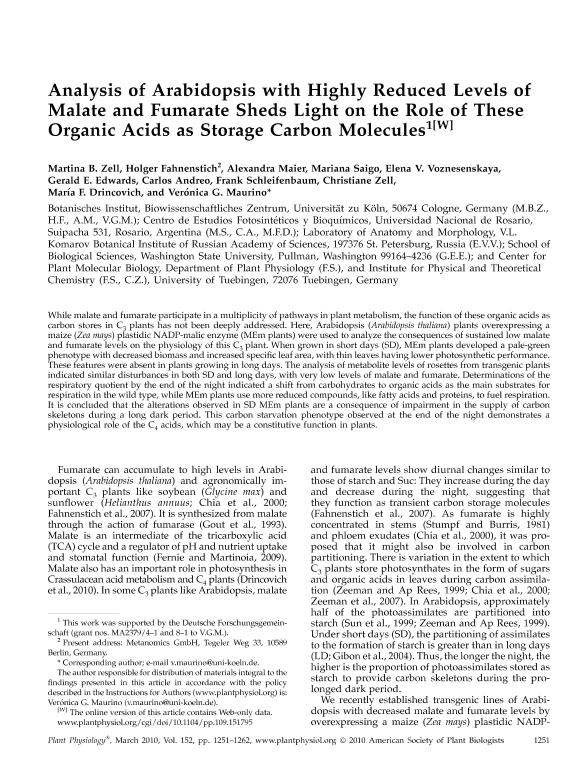Mostrar el registro sencillo del ítem
dc.contributor.author
Zell, Martina B.
dc.contributor.author
Fahnenstich, Holger
dc.contributor.author
Maier, Alexandra
dc.contributor.author
Saigo, Mariana

dc.contributor.author
Voznesenskaya, Elena v.
dc.contributor.author
Edwards, Gerald E.
dc.contributor.author
Andreo, Carlos Santiago

dc.contributor.author
Schleifenbaum, Frank
dc.contributor.author
Zell, Christiane
dc.contributor.author
Drincovich, Maria Fabiana

dc.contributor.author
Maurino, Verónica G.
dc.date.available
2017-04-19T18:11:08Z
dc.date.issued
2010-03
dc.identifier.citation
Zell, Martina B.; Fahnenstich, Holger; Maier, Alexandra; Saigo, Mariana; Voznesenskaya, Elena v.; et al.; Analysis of Arabidopsis with highly reduced levels of malate and fumarate sheds light on the role of these organic acids as storage carbon molecules; American Society Of Plant Biologist; Plant Physiology; 152; 3; 3-2010; 1251-1262
dc.identifier.issn
1532-2548
dc.identifier.uri
http://hdl.handle.net/11336/15453
dc.description.abstract
While malate and fumarate participate in a multiplicity of pathways in plant metabolism, the function of these organic acids as carbon stores in C3 plants has not been deeply addressed. Here, Arabidopsis (Arabidopsis thaliana) plants overexpressing a maize (Zea mays) plastidic NADP-malic enzyme (MEm plants) were used to analyze the consequences of sustained low malate and fumarate levels on the physiology of this C3 plant. When grown in short days (SD), MEm plants developed a pale-green phenotype with decreased biomass and increased specific leaf area, with thin leaves having lower photosynthetic performance. These features were absent in plants growing in long days. The analysis of metabolite levels of rosettes from transgenic plants indicated similar disturbances in both SD and long days, with very low levels of malate and fumarate. Determinations of the respiratory quotient by the end of the night indicated a shift from carbohydrates to organic acids as the main substrates for respiration in the wild type, while MEm plants use more reduced compounds, like fatty acids and proteins, to fuel respiration. It is concluded that the alterations observed in SD MEm plants are a consequence of impairment in the supply of carbon skeletons during a long dark period. This carbon starvation phenotype observed at the end of the night demonstrates a physiological role of the C4 acids, which may be a constitutive function in plants.
dc.format
application/pdf
dc.language.iso
eng
dc.publisher
American Society Of Plant Biologist

dc.rights
info:eu-repo/semantics/openAccess
dc.rights.uri
https://creativecommons.org/licenses/by-nc-sa/2.5/ar/
dc.subject
Organic Acids
dc.subject
Carbon Metabolism
dc.subject
Dark Metabolism
dc.subject
Short Days
dc.subject.classification
Bioquímica y Biología Molecular

dc.subject.classification
Ciencias Biológicas

dc.subject.classification
CIENCIAS NATURALES Y EXACTAS

dc.title
Analysis of Arabidopsis with highly reduced levels of malate and fumarate sheds light on the role of these organic acids as storage carbon molecules
dc.type
info:eu-repo/semantics/article
dc.type
info:ar-repo/semantics/artículo
dc.type
info:eu-repo/semantics/publishedVersion
dc.date.updated
2017-04-18T14:02:20Z
dc.journal.volume
152
dc.journal.number
3
dc.journal.pagination
1251-1262
dc.journal.pais
Estados Unidos

dc.journal.ciudad
Rockville
dc.description.fil
Fil: Zell, Martina B.. Universitat Zu Köln; Alemania
dc.description.fil
Fil: Fahnenstich, Holger. Universitat Zu Köln; Alemania
dc.description.fil
Fil: Maier, Alexandra. Universitat Zu Köln; Alemania
dc.description.fil
Fil: Saigo, Mariana. Consejo Nacional de Investigaciones Científicas y Técnicas. Centro Científico Tecnológico Rosario. Centro de Estudios Fotosintéticos y Bioquímicos (i); Argentina. Universidad Nacional de Rosario; Argentina
dc.description.fil
Fil: Voznesenskaya, Elena v.. Russian Academy of Sciences; Rusia
dc.description.fil
Fil: Edwards, Gerald E.. Washington State University; Estados Unidos
dc.description.fil
Fil: Andreo, Carlos Santiago. Consejo Nacional de Investigaciones Científicas y Técnicas. Centro Científico Tecnológico Rosario. Centro de Estudios Fotosintéticos y Bioquímicos (i); Argentina. Universidad Nacional de Rosario; Argentina
dc.description.fil
Fil: Schleifenbaum, Frank. Universität Tübingen; Alemania
dc.description.fil
Fil: Zell, Christiane. Universität Tübingen; Alemania
dc.description.fil
Fil: Drincovich, Maria Fabiana. Consejo Nacional de Investigaciones Científicas y Técnicas. Centro Científico Tecnológico Rosario. Centro de Estudios Fotosintéticos y Bioquímicos (i); Argentina. Universidad Nacional de Rosario; Argentina
dc.description.fil
Fil: Maurino, Verónica G.. Universitat Zu Köln; Alemania
dc.journal.title
Plant Physiology

dc.relation.alternativeid
info:eu-repo/semantics/altIdentifier/doi/http://dx.doi.org/10.1104/pp.109.151795
dc.relation.alternativeid
info:eu-repo/semantics/altIdentifier/url/http://www.plantphysiol.org/content/152/3/1251
Archivos asociados
